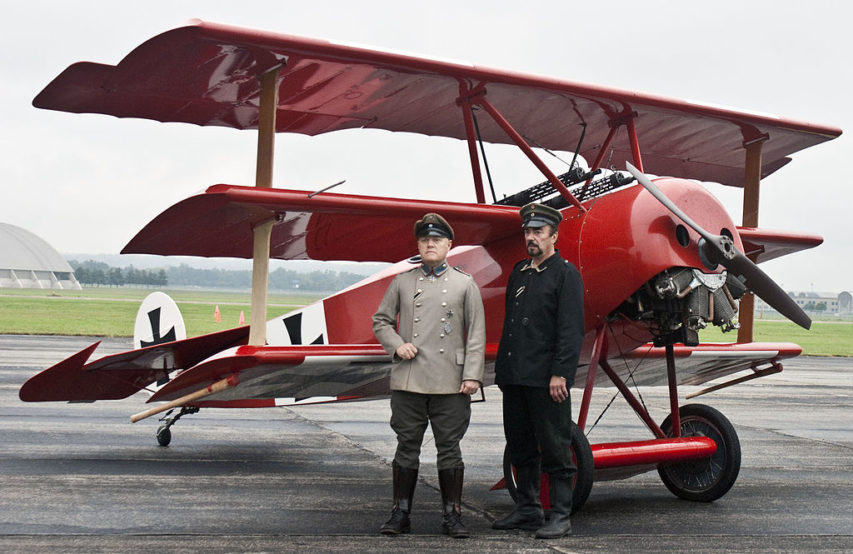At The Register, the story of Dr Peter Brueggemann’s quest to build a close replica of the kind of WW1 aircraft made famous by the Red Baron:

World War I Dawn Patrol Rendezvous DAYTON, Ohio — Reenactors stand in front of a Fokker Dr. I during the World War I Dawn Patrol Rendezvous at the National Museum of the U.S. Air Force, 8 August 2009. (U.S. Air Force photo, via Wikimedia)
A German orthopaedic surgeon in Norfolk has spent £70,000 building himself a flyable full-size replica of the Red Baron’s Fokker Triplane.
Dr Peter Brueggemann built the First World War-era aircraft by hand – even though when he started he couldn’t fly, as ITV News reported.
The bright red Fokker Dreidecker I (German for “three-decker”, or triplane) was built to a set of technical drawings prepared by an American aviation fanatic in the 1970s. No original Dr.Is exist, though a number of replicas have been put together during the 20th century.
Dr Brueggemann even acquired the title of baron from the Principality of Sealand, ready for when his Fokker makes its planned first flight this summer.
He told the telly station: “Being a surgeon has certainly helped and I have used surgical equipment like needles and forceps when stitching materials to the ribs of the plane.”
[…]
Fokker copied the original Dr.I design from British company Sopwith. During the early stages of air fighting in WWI, rate of climb was deemed vitally important. As aeronautical science was still in its infancy – aircraft were built from plywood and canvas, while the relatively primitive rotary engines of the day were only capable of around 110hp – the easiest way of increasing the amount of lift available was to add more wings.
First seeing action in early 1917, the Sopwith Triplane was an instant success. However, a captured example shown to Anthony Fokker, prompting German development of their own version. The first pre-production Dr.I was issued to a frontline unit in August 1917 and proved an instant hit. German fighter squadron commander Manfred von Richthofen recommended the Dr.1 be issued to as many frontline units as possible.
Kinda-sorta related: I’d always wondered about the name “Fokker”, and its regular use in English wartime jokes (“… yes, but this Fokker was flying a Messerschmidt!”). I suspect it’s another of the Dutch “funny” names, which like so many other aspects of European life, can be blamed at least in part on Napoleon:
Poop, testicles, passing wind, peeing, don’t be sad, live long, born naked and jump in the field. These are all Dutch family names. And the list goes on. Where did these names come from? Why do so many Dutch people have funny names?
Most people think these names came about during the French occupation of the Netherlands, from 1795 to 1813. The French introduced a population registry, and anyone who did not already have a last name had to take one.
And, indeed, some names did come about in this way. It’s easy to imagine the following scene: a French census taker who does not speak Dutch is writing down people’s last names. One man tells the census taker his name is Jacobson. The next man in line, also called Jacobson, says to the census taker “the same”. So the census taker, not understanding Dutch, writes down ‘t Zelfde, meaning “the same”. And that’s what his descendants are called to this day.
Disdain
Another explanation for strange names is that Dutch subjects showed their disdain for the French occupiers by giving ridiculous names. In the end, the joke backfired – the French left the Low Countries, and the joker’s descendants have been forced for generations to answer to some silly surname.This explanation for how these silly names came about makes a nice story. But it is only partially true. Most Dutch families were already using last names well before the French occupation. And many of the strange names evolved from other names, or had other meanings than they have now.
Gerrit Bloothooft, an expert in names at Utrecht University, says less than 20 percent of Dutch surnames can be traced to the French occupation. Most Dutch people began using last names during the 17th century, the Dutch golden age.
The practice of using patronymics – or calling oneself “son” or “daughter” of someone – was no longer practical. So professions, places or personal characteristics were used. And some names can be attributed to local humour – colourful nicknames that evolved into last names.
Yvonne Parks provided a list of some of the other “funny” Dutch names:
In 1811, the French under Napoleon occupied the Netherlands. They started having a census for the purpose of taxation, and forced everyone to have a family name, which was not a common practice for the Dutch. The Dutch thought this would be a temporary measure, and took on comical or offensive sounding names as a practical joke on their French occupiers.
Some examples are:
- Suikerbuik (Sugarbelly)
- Spring in t’Veld (Jump in the Field)
- Uiekruier (Onion-crier)
- Naaktgeboren (Born naked)
- Poepjes (Little shit)
- Schooier (Beggar)
- Scheefnek (Crooked-neck)
- Rotmensen (Rotten people)
- Zeldenthuis (Rarely at home)
- Zondervan (without a surname)
- Borst (breast)
- Piest (to urinate)
- Paardebek (Horses mouth)
- Zonderkop (without a head)
- Vroegindeweij (early in the field)
- Uyttewiliigen (out of the willows)
- Kaasenbrood (Cheese and bread)
- Gekkehuis (Crazy House)
- Niemand (Nobody)
They had no way to know that these names would follow their descendants for centuries! *doh!*



